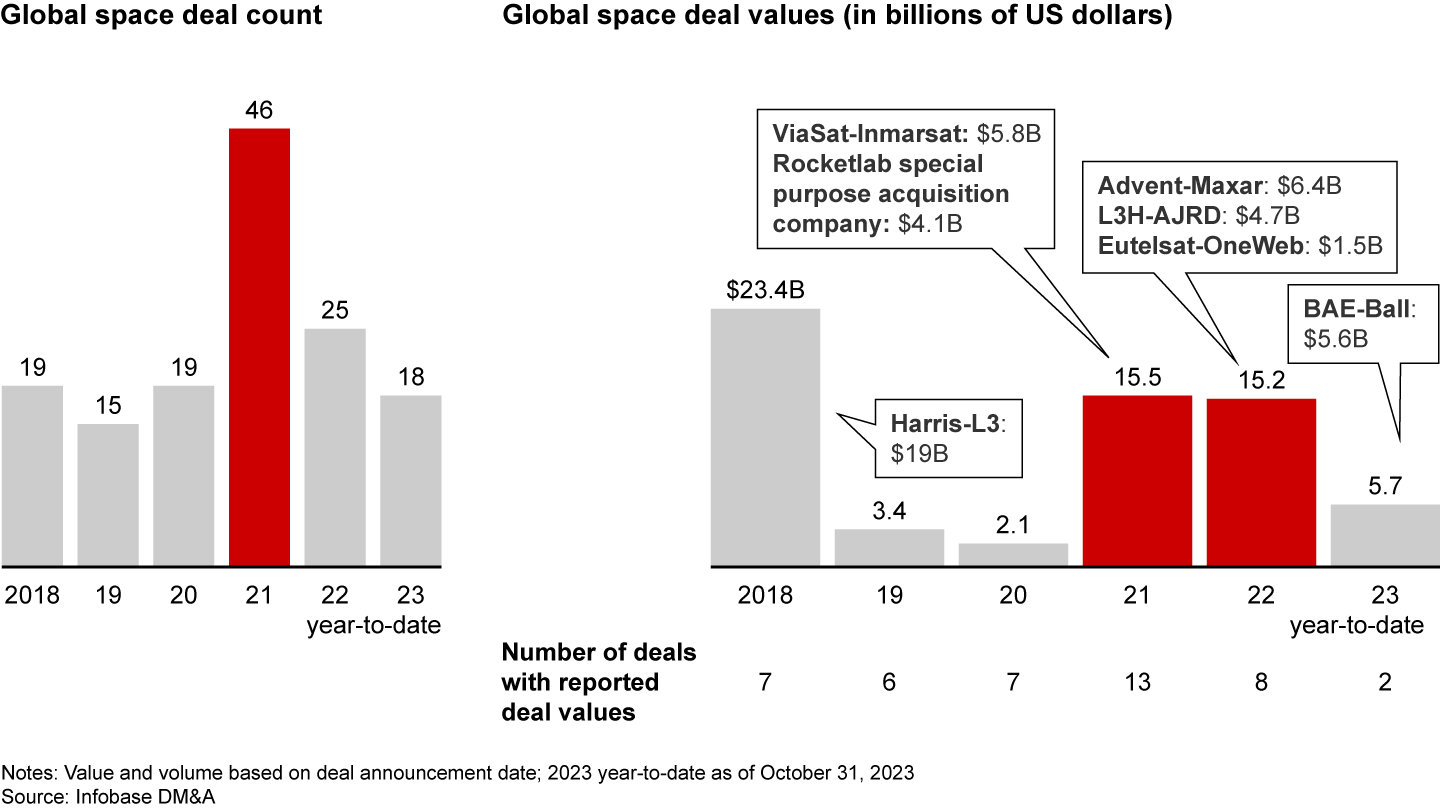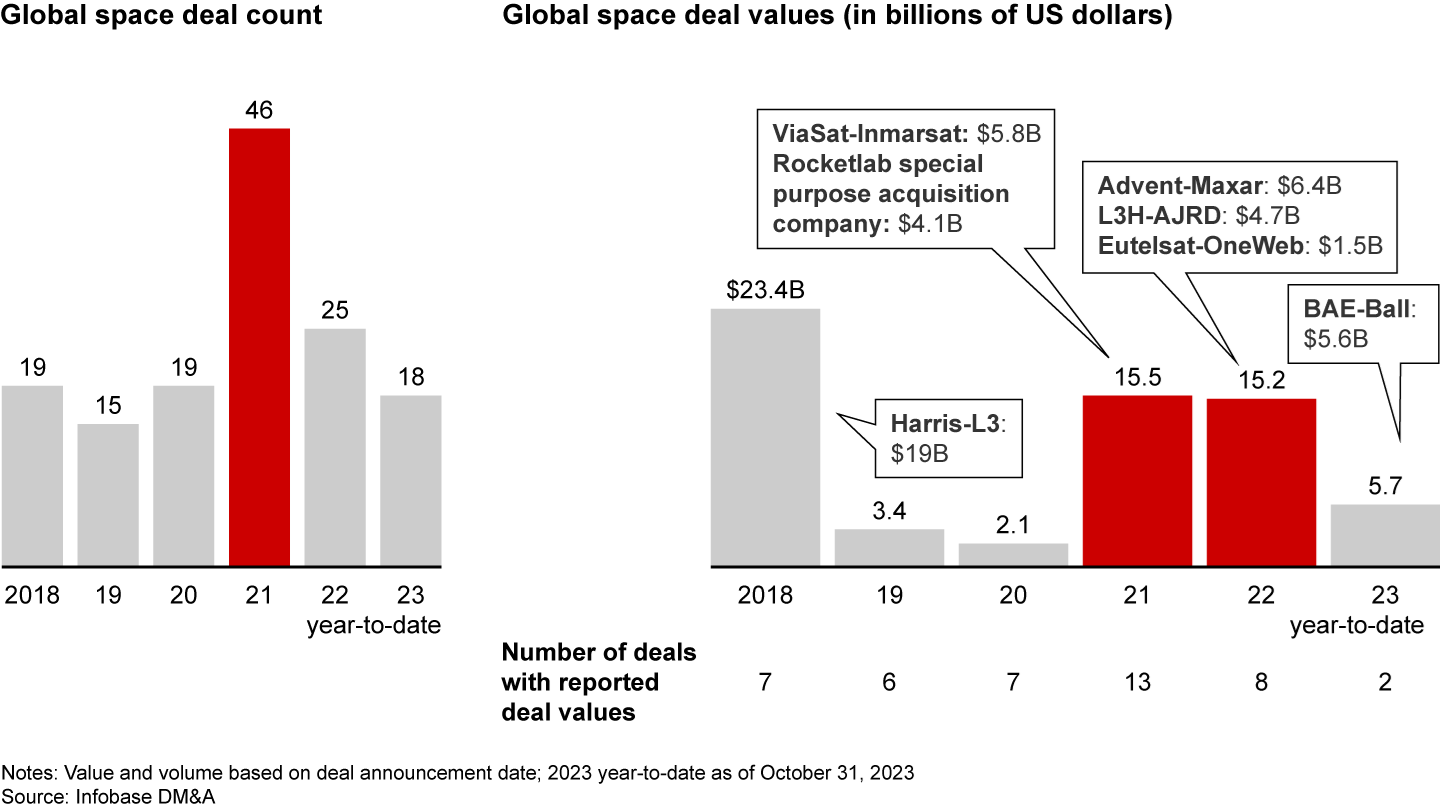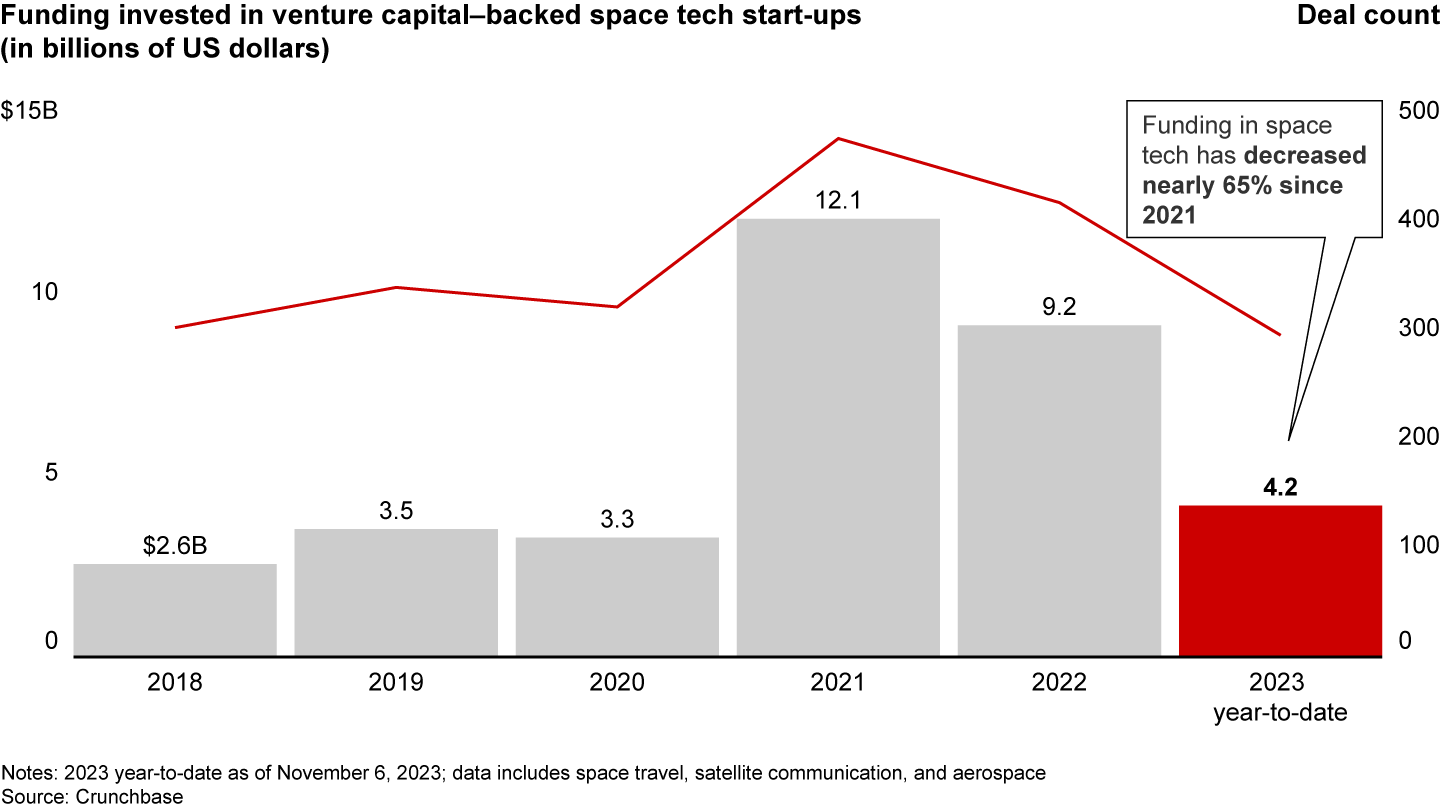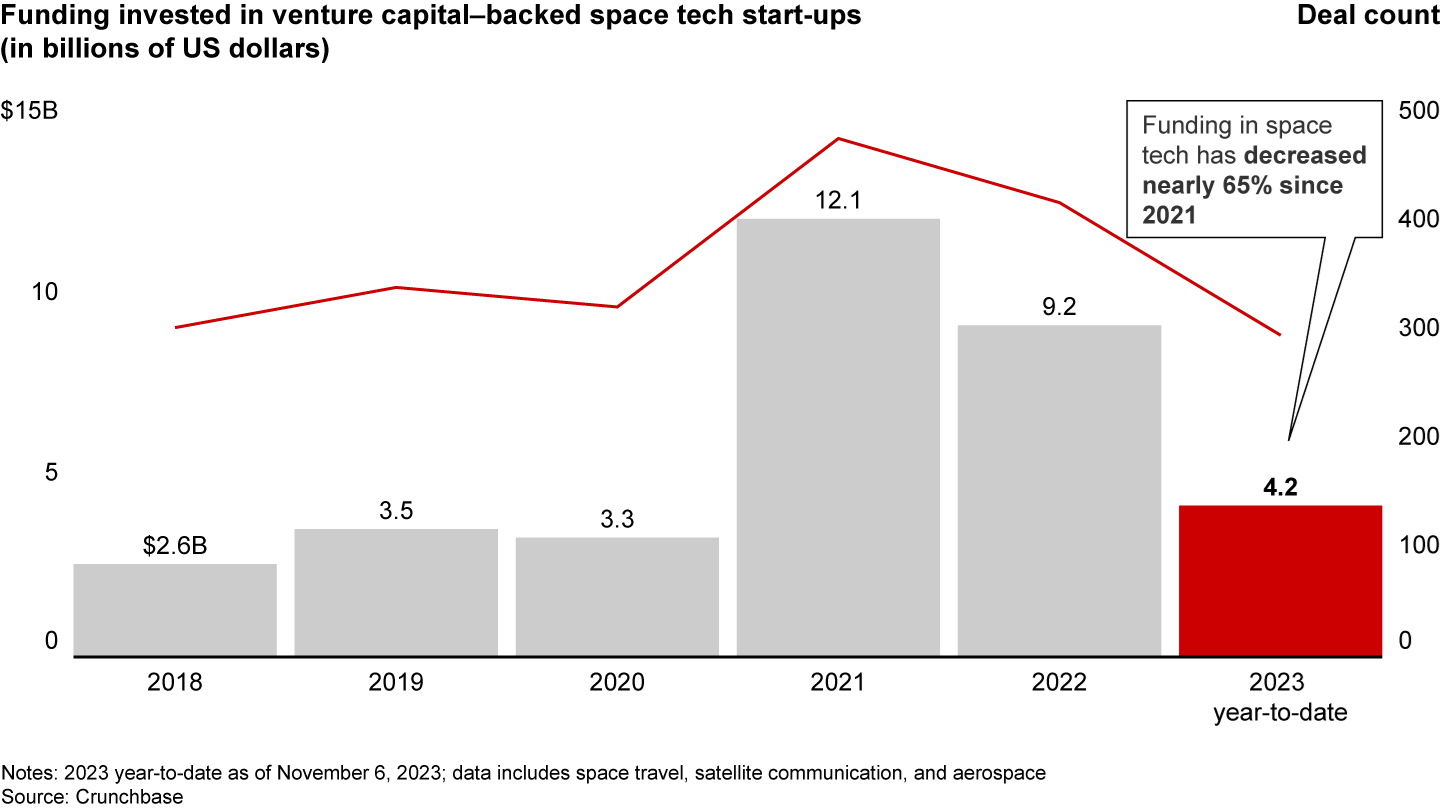M&A Report

At a Glance
- Space access and capability is now a national security and geopolitical imperative for governments.
- SpaceX continues to drive down the cost of launches, pressuring other launch providers and opening further space opportunities.
- Private investment in space has declined drastically, increasing M&A’s role as a tool for growth and innovation.
- Looking ahead, we believe that portfolio reshaping and lower valuations will spur M&A activity.
Este artigo faz parte do Relatório de Fusões e Aquisições de 2023 da Bain.
In 2023, the space industry saw a string of multibillion-dollar deals announced in prior years officially close (see Figure 1). Among the largest of those were ViaSat’s $5.8 billion acquisition of Inmarsat, Advent’s $6.4 billion purchase of Maxar, and the $1.5 billion Eutelsat-OneWeb merger.


As we look forward to 2024, we see the space industry entering a new era triggered by a higher interest rate environment and defined by reduced costs for space access and the emergence of space as a fully contested geopolitical arena.
As these and other forces play out, a reconfigured industry is coming into focus, with established players reshaping their portfolios and fragmented companies finding the need to consolidate.
Strategic buyers have a unique opportunity. Technology and teams that benefited from the surge in private financing will find it more difficult to develop space technology and build businesses in a capital-constrained world. Valuations are coming back down to earth, and buyers have the chance to acquire to accelerate their own capabilities and innovation at a price that more accurately reflects value. Also, there will be opportunities for portfolio restructuring as governments select key architectures and companies pick where they will focus their efforts. There will be strong industrial logic for building capabilities through acquisitions of orphaned business units from competitors.
For their part, growth investors can take advantage of the repricing of the long tail of space technology companies by selecting assets that combine a differentiated technology with a realistic business model. Many space companies will need capital infusions to bring their technology to market, and they will be more willing now than during any time in the past five years to open themselves up to robust diligence.
Consolidators have an opportunity to develop the space supply chain by building out merchant suppliers in the key technology categories for winning architectures. Across the industry, the best companies will invest to understand which segments of the value chain have the right prospects for growth and profitability—and that’s where they’ll focus.
We see four major themes in the space industry that will be reflected in M&A activity in 2024 and beyond.
Space tech is getting less funding. The year 2021 set a record in space funding, with more than $12 billion invested in space companies. In 2022, that amount dropped to $9 billion, and then the first three quarters of 2023 brought that investment total significantly lower, to only $4.2 billion (see Figure 2). Many space companies that went public in recent years continue to struggle, with most performing below their initial listing price, and many receiving letters of impending delisting.


The lingering higher interest rate environment will likely have a continued chilling effect on space companies’ ability to raise additional capital. The majority of space companies are “default dead”—that is, they are not profit-generating entities—given the high capital costs and longer-horizon deep-tech nature of their product.
Despite the tough funding environment, there are worthwhile technologies and teams within these companies. Larger established players could benefit from fire-sale pricing on tech and teams that are unable to raise money. These larger companies with cash flow supported from other parts of the portfolio could use this as an opportunity to accelerate future revenue opportunities from space by harnessing the innovations from a generation of space companies.
SpaceX continues to drive down the cost of space launches. SpaceX completed the second test flight of its superheavy Starship launch vehicle. While the test did not complete all objectives, it was an improvement from the first test and an indication that the company is getting closer to fielding a vehicle that could reduce cost per kilogram to low Earth orbit (LEO) by 50 to 80 times.
This marks the commoditization of space launches, and it will put substantial pressure on other active launch providers and those that hope to compete but have not yet successfully launched. It will also allow for more business cases to close for companies that hope to offer services in space—everything from communications and remote sensing satellite companies to commercial space stations, on-orbit manufacturing, and asteroid mining operations.
The drastically lower launch costs will likely cause a meaningful shuffle in established space players’ portfolios, with a surge of new entrants buying winners or selling off their space-focused business units as the speed of innovation and competition intensifies. Adding to the opportunities: The European Space Agency moved in November to open its launches to competition as of 2025.
LEOs fully emerge as a national security priority. The US Space Development Agency (SDA) is providing more than $8 billion in funding to the layered network of military satellites known as Proliferated Warfighter Space Architecture (PWSA). It is the government’s first major investment in proliferated LEO and the cornerstone of the US Department of Defense’s (DoD’s) future communications and threat detection capabilities.
Similarly, Europe has adopted in 2023 the IRIS2 project (Infrastructure for Resilience, Interconnection and Security by Satellites) to secure the EU’s resilience to and capacity to answer threats. Nearly half of the €6 billion estimated budget for this LEO communications constellation will be covered by EU and ESA funding, the rest coming from the private sector.
This architecture attempts to achieve space resiliency through rapid replacement and redundant satellites that are lower cost than the satellites that make up much of the DoD’s space assets today. The SDA is now making substantial investments, including a $1.5 billion Transport Layer award to Lockheed Martin and Northrop Grumman.
The procurement methodology for the SDA involved starting with a wide net of smaller awards to a greater number of companies with the intent of narrowing the number and increasing the award size. As winners and losers emerge, there will likely be portfolio restructuring, and those that win will be looking to create the most effective strategy for delivering. That will mean supply chain vertical integration in some areas and the emergence of component merchant suppliers in others. Those that lose will be looking to divest capabilities that will no longer be relevant for their portfolio.
Additionally, the desire to create a secure domestic supply chain for higher-rate production satellites could provide opportunities for roll-up acquisition plays for critical parts of the supply chain, especially around hardened and secure defense electronics and secure subsystems.
Lunar and deep space is the next frontier for nation building. NASA’s Deep Space Exploration programs, which include the Artemis and Mars campaigns, will allocate nearly $40 billion in funding over the next five years to advance the US’s presence on the moon and beyond. (Because of the Outer Space Treaty, the DoD has been less explicit about any aspirations for military outposts in space.)
India completed its historic lunar landing on the south pole of the moon, and Russia is recovering from its recent failure of the same objective. More important: The Chinese Lunar Exploration Program is the most ambitious and well-funded effort in China’s history to establish a permanent base on the lunar surface.
The infrastructure needed to build new habitats in cislunar orbit, the lunar surface, and beyond will require new industrial capabilities. Many companies are emerging to provide these services, but starting in 2024 and continuing over the coming five years, there will likely be a first round of consolidation as the exact technologies needed emerge and as the timelines for public funding become clearer.
For M&A teams, this is the moment to create lasting value for years to come. The best companies will develop focused and tailored investment theses that demonstrate how a potential deal supports their long-term space strategy. In addition to the robust due diligence capabilities that help an acquirer gain confidence in a target, winners will develop their ability to partner and invest in a way that will unlock capabilities while fostering the more innovative and agile elements of a target’s culture. For instance, since acquiring Millennium Space Systems, Boeing has largely allowed the subsidiary to operate at arm’s length, retaining its more rapid prototyping capability, which provides a model for innovation across Boeing’s space portfolio. In return, Boeing has shared its manufacturing and mission assurance expertise to help Millennium to scale. Companies need to find the right fit to their space portfolio and bring them in without destroying the capabilities that may require years to fully mature and commercialize.
Este artigo faz parte do Relatório de Fusões e Aquisições de 2023 da Bain.